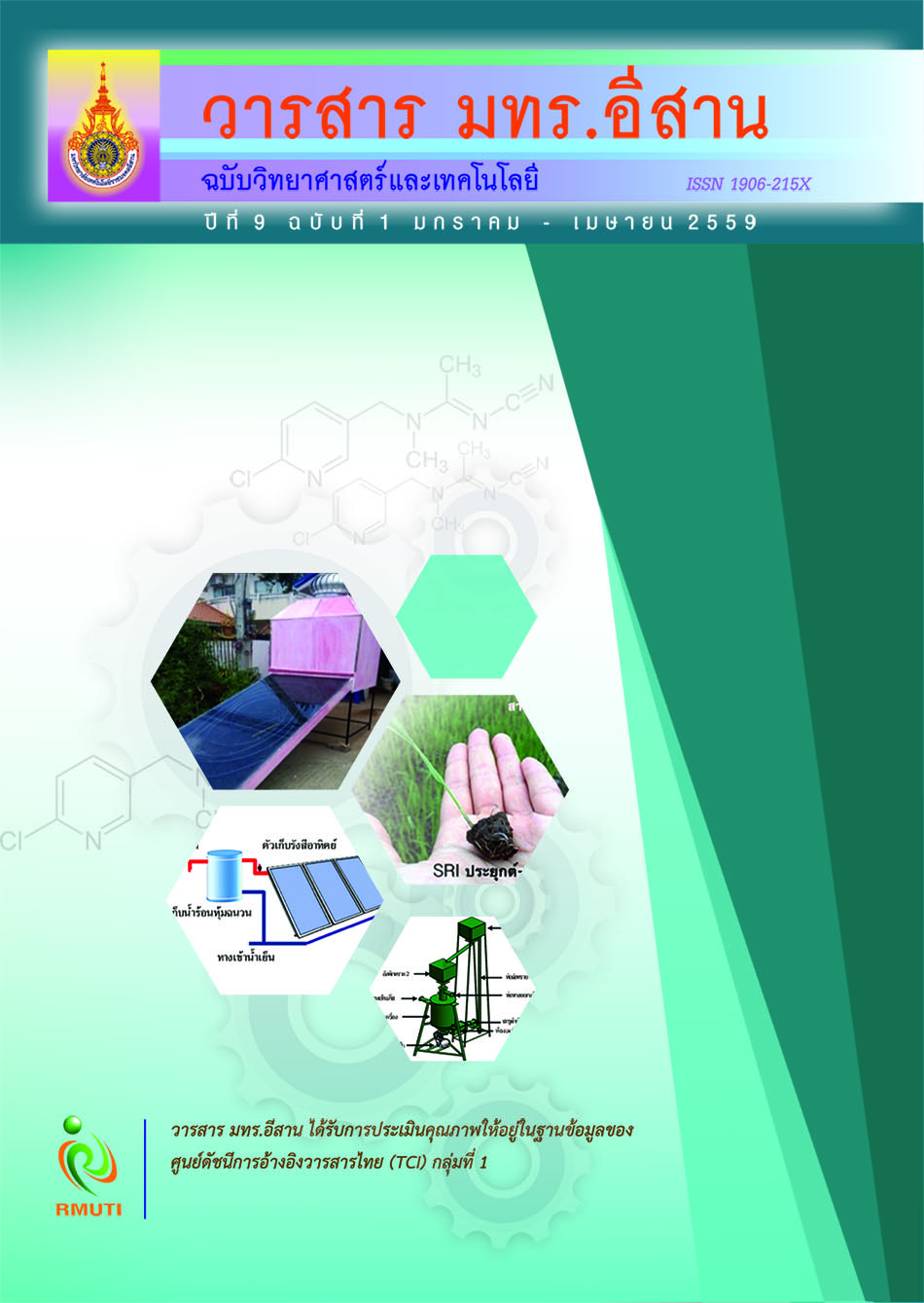ศึกษาความเป็นไปได้ในการผลิตถาดรองผลไม้โดยใช้ขุยมะพร้าว กากกาแฟ ผักตบชวา ด่างทับทิม และเยื่อกระดาษเป็นส่วนผสม (Study to Ossibility in Made Fruit Tray by using Coconut Hust, Coffee Pulp, Water Hyacinth, Postassiumpermanganate and Tissue Paper Mixed)
Main Article Content
Abstract
บทคัดย่อ
งานวิจัยนี้เป็นการศึกษาความเป็นไปได้ในการใช้ (1) ขุยมะพร้าว (2) ผักตบชวา (3) กากกาแฟ (4) ด่างทับทิม
และ (5) เยื่อกระดาษ ในการทำถาดรองผลไม้ โดยไม่ใช้สารเคมีและความร้อน ด้วยวิธีอัดขึ้นรูปจากแม่พิมพ์
ปูนปาสเตอร์ วิธีการเริ่มจากนำวัสดุที่เตรียมไว้มาผสมกัน 8 อัตราส่วนผสม คือ T1 (1+5) T2 (5+ 4)
T3 (5+2) T4 (5+3) T5 (5+2+4) T6 (5+4+2) T7 (5+4+3+1) และ T8 (5+2+3+4) แล้วขึ้นรูปด้วยวิธีอัด
ขึ้นรูปนำไปตากให้แห้ง การทดสอบประกอบด้วย การทดสอบการรับแรงดึง 3 จุดต่อแผ่น การทดสอบ
ภายใต้แรงกดแบบสถิตเป็นเวลา 15 วัน และทดสอบการต้านแรงสั่นสะเทือนที่ความถี่ 4 เฮิรตซ์เป็นเวลา
1 ชั่วโมง ผลการทดลองพบว่าการทดสอบแรงดึง T3 และ T6 มีความสามารถรับแรงดึงสูง เนื่องจาก
มีส่วนผสมของผักตบชวา ซึ่งมีลักษณะโครงสร้างเป็นฟองนํ้า จึงทำให้มีการยึดเกาะของส่วนผสมดี
อัดตัวกันแน่น และยังมีความยืดหยุ่น การทดสอบภายใต้แรงกดแบบสถิตพบว่า ถาดรองผลไม้มี
การยุบตัวอย่างต่อเนื่องสมํ่าเสมอ โดยแต่ละช่วงเวลามีการยุบตัวเพิ่มมากขึ้น การทดสอบแรงต้าน
การสั่นสะเทือนพบว่า ถาดรองผลไม้ไม่มีความเสียหาย ไม่มีรอยแตกร้าว เนื่องจากวัสดุที่ใช้มีโครงสร้าง
ที่สามารถยืดหยุ่น จึงรับแรงการสั่นสะเทือนได้ดังนั้นพอสรุปได้ว่า T3 สามารถนำมาใช้เป็นถาดรองผลไม้
ได้ที่ดีสุด
Abstract
This research was to study the feasibility to made fruits tray by using (1) coconut hust
(2) water hyacinth (3) coffee pulp (4) potassium permanganate and (5) paper pulp.
The tray were formed up using plaster molds. The material were prepared by mixing
8 ratio, T1 (1+5) T2 (5+ 4) T3 (5+2) T4 (5+3) T5 (5+2+4) T6 (5+4+2) T7 (5+4+3+1) and
T8 (5+2+3+4), formed up out and drying. The testings were carried out by tensile
3 points per plate, testing under static pressure for 15 days and anti-vibration
frequency 4 Hz for 1 hr. The results showed that T3 and T6 also have high tensile
strength because a tray consisted of water hyacinth was flexible. For the test under
static pressure, it was found that fruit tray with the dissolution samples was
consistent. For the anti-vibration testing, it was found that T3 can be used as a fruit
tray, because the material structure is flexible.
Article Details
References
testing of shipping container. Selected ASTM Standard on Packaging 3rd ED.
Baltimore, USA
Tannisbamrungsab. (1998). Coffee pulp. Access (17 July 2014). Available (http//www.
49tennis.com/earthworm/coffee.html)
Foodnetworksolution. (2011). Structure development packaging. past 5. Cushioning
materialsand closed box. Food Packaging. Access (5 April 2014). Available (http://
www.foodnetworksolution.com/)
Instron. (2014). Testing the adhesion of the glue of veneer and lumber. Testing Solutions
(ASTM D1037) Access (4April 2014). Available (http://www.instron.co.th/wa/
solutions/ASTM_D1037_Internal_Bond_Test_Wood.aspx)
Nikhom, R. (2005). Food packaging technology. Learning documentcompose. Department
Post-Harvest and Processing Engineering. Faculty of Engineering and Architecture.
Rajamangala University of Technology Isan. pp. 43-45
Niramol, W. (2008). Development of Cushioning Material from Waste Corrugated Paper
for Nam Dok Mai Mango (Mangiferaindica Linn.) Distribution. Thesis Master
of Science. Department Product Development. Kasetsart University. p. 106.
Access (4 April 2014). Available (http://doi1.nrct.go.th/?page=resolve_doi&
resolve_doi=10.14457/KU.the.2008.63)
Noppol, K. (2011). Water hyacinth. Plant 5. Conservation and Utilization Unit. Central
Laboratory and Greenhouse Complex. Kasetsart University Kamphaeng Saen
Campus. Access (3 April 2014). Available (http://clgc.agri.kps.ku.ac.th/index.php/
linkweed/372-eichornia)
Wikipedia. (2012). Coconut hust. Access (18 July 2014). Available (https://th.wikipedia.
org/wiki/)
Warporn, N. (2009). Production and use of handicraft paper made from banana trees
mixed with waste paper. ThesisMaster of arts. Ramkhamhaeng University. p. 77.
Access (18 July 2014). Available (http://tdc.thailis.or.th/tdc/advance.php)
Saowaluk Taechutrakul. (2000). Development of Ethylene Scavenging Packaging from
Recycled Pulp and Charcoal to Extend Storage Life of Fresh Tomatoes. Thesis
Master of Science. Department Printing and Packaging Technology. Faculty
Industrial Education and Technology. King Mongkut’s University of Technology
Thonburi. p. 143. Access (18 July 2014). Available (http://tdc.thailis.or.th/tdc/
advance.php)


